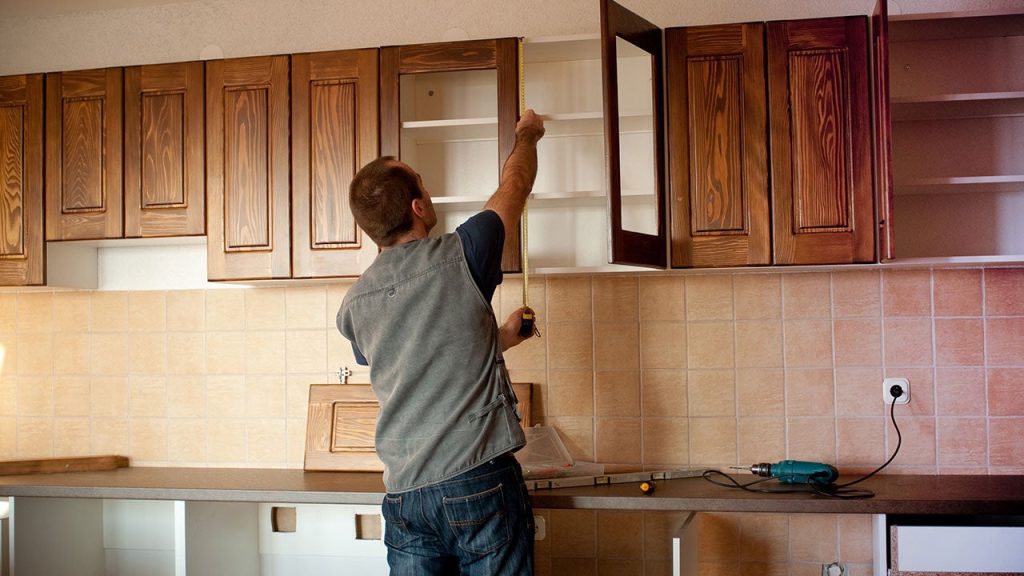Key takeaways
- Prequalify with multiple lenders to get the best terms when looking into different loan options for your next home improvement project.
- Financing a home project takes planning, so consider every financing option before committing to one.
- If possible, the best way to pay for a home improvement project is to save up and pay out-of-pocket to avoid taking on large amounts of debt.
Thinking ahead about financing your home project is essential to avoid added costs and future financial problems. While saving up for a specific project is the best way to pay for a home upgrade, it isn’t always possible. Instead, you may need to fund your project another way.
There are multiple home improvement financing options, including home improvement loans, home equity products, credit cards and government loans. The right one for you will depend on your project and financial goals.
Average cost of a home improvement
The average cost of a home renovation is $51,939, though it can range from $19,524 to $87,743, according to Angi. Keep in mind that, while this figure is the national average, every home improvement project can fluctuate greatly based on the size and location of your home, type of project and timing. However, even smaller, low-cost improvements can still be pricey, thanks to inflation.
Inflation is at one of its highest points in decades, making everything — including home improvements — more expensive. And it’s causing homeowners to rethink their projects. Among homeowners who postponed or canceled a home improvement, repair or maintenance project in 2023, an average of 61 percent did so because of budget or financial concerns, according to Home Improvement Research Institute’s Monthly Homeowner Activities and Sentiments Tracker.
Home improvement statistics
In 2024, Houzz surveyed 32,615 U.S. homeowners about their 2023 renovation activities and 2024 plans. Here’s what the Home Renovation Trends report found.
- The top triggers for starting a renovation in 2023 were finally having time (39 percent) and finally having the financial means to do so (36 percent).
- The median spend on home renovations in 2023 was $24,000.
- Bathroom and kitchen renos cost the most in 2023, jumping 11 percent and 20 percent to median costs of $15,000 and $24,000, respectively.
- Cash was the most popular way to pay for home improvements, with 83 percent of homeowners using money from savings. Financing options came in second and third, with 37 percent using credit cards and 14 percent using a secured home loan.
- Almost 40 percent of renovating homeowners went over budget in 2023.
- The most renovated homes in 2023 were ones built between 1981 and 2000.
- The median amount of money homeowners plan to spend on home renovations in 2024 is $15,000.
- Of the projects planned in 2024, renovating is the priority of 52 percent of homeowners. Meanwhile, 46 percent plan to decorate and 33 percent plan to tackle repairs.
7 best ways to finance home improvements
Home improvement projects can be expensive and often require financing. For many homeowners, building up your savings will be the least expensive option. But if you need to make emergency repairs or cover a large expense, options like a loan or line of credit may be more appropriate.
1. Savings
The best way to pay for your home renovation is to save and pay with cash. However, saving money has one major drawback — it takes time. When you pay cash instead of financing, you may have to wait years to cover a large project.
The amount you need to save depends on the type of renovation and the project’s scope. If you want to finance the whole project by saving, start small with less expensive projects. This can help you avoid spending more than you intended.
Benefits
- No additional debt
- No accruing interest
- Avoid credit checks and missed payments
- Less chance of overspending
Drawbacks
- Potentially longer timeline
- May not work for emergency repairs or renovations
- Less cash available for other needs
- No positive impact on credit score
2. Home improvement loans
Home improvement loans are unsecured personal loans offered by banks, credit unions and a number of online lenders. Because the loans are unsecured, you don’t need to use your house as collateral to qualify. If you qualify, funding comes quickly, within as little as a few days.
As unsecured loans, home improvement loans typically have higher rates than secured loans. However, unlike secured loans, you don’t risk losing your home or property if you default.
The maximum home improvement loan amount you can borrow is $100,000 — but most lenders have much lower caps. The minimum you can borrow may be as low as $1,000, making them good for small or mid-sized projects.
Benefits
- Funding within a few days
- Little-to-no additional fees
- No risk of foreclosure or home loss
- Good for mid-sized projects
Drawbacks
- Potentially high interest rates
- Short loan terms with potentially high monthly payments
- Qualification depends on credit and personal finances
- Potential to overspend
3. Home equity line of credit (HELOC)
A HELOC is a secured loan backed by the equity in your home. It acts as a revolving line of credit, so you can borrow what you need when you need it — up to your credit limit. Because a HELOC is secured by your home, you can qualify for lower interest rates than you would with an unsecured personal loan.
Keep in mind that most HELOC interest rates are variable, which means your payments can increase depending on market conditions. And because HELOCs use your home as collateral, you risk foreclosure if you are unable to repay.
Benefits
- Flexible repayment options for up to 30 years
- Interest may be tax deductible
- Lower interest rates than other financing options
- Higher borrowing amounts for bigger projects
Drawbacks
- Variable interest rates may increase
- Higher potential to overspend with a line of credit
- Must have at least 15 percent equity in your home
- Risk of foreclosure if you default
4. Home equity loan
A recent home equity insights survey by Bankrate found that 55% of current homeowners consider home improvements or repairs a good reason to tap into home equity. If you want to access your existing equity but don’t need revolving credit, you could apply for a home equity loan, also known as a second mortgage. This loan is paid out in a lump sum that you can repay over a number of years in regular fixed monthly payments.
Home equity loans typically allow you to borrow more than a standard home improvement loan. Like a HELOC, a home equity loan uses your home as collateral, so stay current with payments to avoid default and foreclosure.
Benefits
- Fixed interest rates with predictable monthly payments
- Interest may be tax deductible
- Over-spending is more difficult than with a credit line
Drawbacks
- Higher credit score needed to qualify for the best rates
- Risk of foreclosure if you default
- Potential for underwater mortgage if property value declines
5. Cash-out refinance
A cash-out refinance replaces your current mortgage with a new, larger loan. It also allows you to keep the difference between the new amount and what you owe. You can then use this money for home improvements.
A cash-out refinance is a good option for homeowners who qualify for a better rate than their existing mortgage and don’t want an additional monthly loan payment.
Benefits
- Adjust your loan term or switch to a fixed rate
- No additional monthly payment
- Potential to secure a lower interest rate
Drawbacks
- Mortgage debt increases
- Additional costs, including appraisal and closing costs
- Could increase interest rate and monthly payment
6. Credit cards
If you’re making minor updates to your home, using your credit card for home improvements might be one of the best financing options. That said, credit cards have notoriously high interest rates, so it’s important to have a plan to pay off your balance before you start spending.
If you qualify for a 0 percent introductory APR card, you could avoid interest if you pay back the balance by the end of the introductory period. This is in addition to the rewards options offered by many credit card companies.
Benefits
- Potential to earn cashback perks and other credit card rewards
- Borrow money as you need it
- 0% APR cards can save you thousands in interest
Drawbacks
- High interest rates
- Potential to get in a cycle of debt
- Multiple credit cards may be difficult to keep up with
7. Government loans
Government loans can provide savings on borrowing costs, like interest and insurance. They are need- and location-based, but they tend to have lower interest rates and better terms than regular loans. This is because the government insures the lender against potential loss.
A HUD Title I Property Improvement Loan lets you borrow up to $25,000 without any home equity. They can be a good option if you’ve recently purchased your home and need to make upgrades — provided your loan goes to approved renovations, not luxury upgrades.
There are also VA cash-out refinance loans for individuals who meet lender and VA guidelines, including being an active-duty service member, veteran or surviving spouse. For those who qualify, a VA loan could provide funds that can be used for home improvements, among other purposes.
Benefits
- Work with a government-approved lender
- Loans are backed by the government
- People with less-than-stellar credit or a thin credit history may qualify
Drawbacks
- Funds must be used to increase the property’s livability
- More stringent eligibility requirements
- Loan amounts may be limited
Financing for emergency home repairs
In addition to these options, you can file a home insurance claim if you need to cover an emergency repair. But while your insurance may cover the repair, it doesn’t mean making the claim is totally free.
Homeowners insurance costs typically include steep deductibles, often between $1,500 to $5,000. This can be a difficult amount to manage — Bankrate’s annual Emergency Savings Report found that 59 percent of Americans said they were uncomfortable with their level of emergency savings. Moreover, insurance claims may take a while to process, and not all emergency repairs are covered.
If you don’t have time to wait for an insurance claim, a loan could be your best option. Home improvement loans and credit cards work best for smaller repairs, but larger repairs may require a home equity loan or HELOC.
Financing for emergencies with bad credit
If you struggle with your credit and are dealing with a home repair emergency, there are lenders that offer home improvement loans for bad credit.
You can also consider an option like a debt consolidation loan to simplify your finances. These loans allow you to combine multiple debts into one payment, sometimes with a lower interest rate. It isn’t cash directly for an emergency repair, but it can give you more room in your monthly budget. This way, you can put money toward savings or additional repairs as needed.
How to choose the best home renovation financing option
You may have many options when it comes to paying for your project, but not all of them will fit your goals. Consider the time, cost and scope of the project in addition to your finances when determining the best way to pay for home improvements.
- Time: If you have some time before you need to get the project done, create a plan to save for all — or some — of the cost. Saving ahead of time will help you cut down on the interest you pay.
- Cost and scope of the project: Estimating cost and scope can help you determine what kind of financing you need. Smaller improvements may only need a small personal loan, while larger projects may need a home equity loan.
- Financial situation: Your credit score, debt-to-income (DTI) ratio and available home equity can impact your loan amount and interest rate. Before you apply, know your credit score and review your budget to make sure you can afford an additional monthly payment.
- Financial goals: Any home improvement financing will mean taking on additional debt. If you want to avoid an additional monthly payment, build your savings or consider a cash-out refinance.
- Current interest rates: If you purchased a home or refinanced when rates were low, a cash-out refinance may not be the best option since you’ll get a higher interest rate. However, if your new interest rate will be lower than your current one, a cash-out refinance may be a great option for receiving funds and saving money.
The bottom line
Financing a home project takes planning. Choose the best financing path for your project and financial situation. When looking into different home improvement loan options, compare lenders to get the best terms and look for offers that will benefit you most down the road.
Read the full article here












